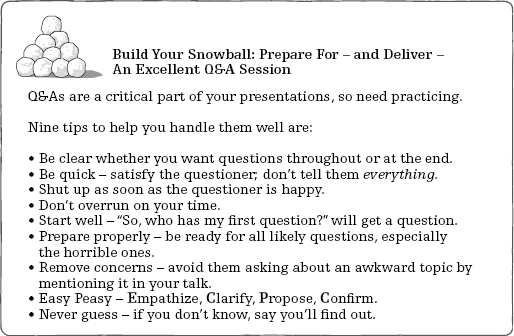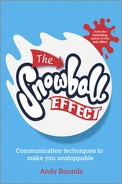42
When you want to prepare for – and deliver – an excellent Q&A session
We’ve all sat through great presentations which were ruined by a tedious Q&A. It just ends up depressing for everyone.
Since Q&As make or break your presentations, you must be brilliant at them. But, despite their importance, most people don’t give them the attention they deserve. Do these pie charts sound like you?

You’ll have your own proportions for your situation of course. But, in my experience, it’s rare to find people who practice Q&As as much as they should, given how important they are.
Here are nine simple techniques to help you deliver excellent Q&As:
1. Be clear
Tell people upfront whether you want questions during your talk, or at the end (it’s often a good idea to check protocol with the organizer beforehand).
2. Be quick
When Mr. X asks a question, it’s quite possible only Mr. X cares about the answer. Don’t assume the whole audience does. Once you realize you might be boring everybody apart from Mr. X, your answers become much more punchy.
3. Shut up
Once Mr. X is happy with your answer, move on – even if you know more about the topic.
4. Don’t overrun
Your audience thinks the Q&A is part of your allotted time. So don’t allow it to cause you to overrun. Nobody’s ever grateful you did.
If you think you might go over your time, ask them whether they want you to continue or to wrap things up.
5. Start well
Avoid the dreaded tumbleweed moment that often follows “Does anyone have a question?” Instead, use the more positive “So, who has my first question?”
6. Prepare properly
Rehearse answers to likely questions, including the ones you’re dreading.
After all, if you don’t, you can pretty much guarantee somebody will ask them, and you then need to create your wonderful answer “live” in front of a potentially hostile audience.
7. Remove concerns
If you know your audience is worried about a topic, pre-empt and remove their concerns during your presentation – “I know that many of you are worried about the cost of this. Let me put your minds at rest by showing that . . .”
If you don’t, they might ask awkward questions about it.
Or, even worse, they won’t – which means they’ll leave the room still worried.
8. Easy Peasy
Here’s a technique that helps you frame answers to difficult questions. It’s one that’s often taught on Customer Service courses – ECPC (Easy Peasy):
9. Never guess
If you don’t know the answer to a question, never guess. It’s the wrong thing to do. And people see right through it, whatever you think. Plus, you have to remember what you’ve said – and you probably won’t.
Instead, say something like “That’s a great question. I don’t have all the information to answer it now. I’ll speak to Mrs. X this afternoon, and promise to get back to you before the end of the day.”
Do all nine, and your Q&As will be more impactful. This means you will be.

